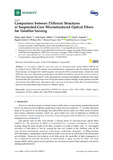Mostrar el registro sencillo del ítem
Comparison between different structures of suspended-core microstructured optical fibers for volatiles sensing
| dc.creator | López Torres, Diego | es_ES |
| dc.creator | López Aldaba, Aitor | es_ES |
| dc.creator | Elosúa Aguado, César | es_ES |
| dc.creator | Auguste, Jean-Louis | es_ES |
| dc.creator | Jamier, Raphael | es_ES |
| dc.creator | Roy, Philippe | es_ES |
| dc.creator | López-Amo Sáinz, Manuel | es_ES |
| dc.creator | Arregui San Martín, Francisco Javier | es_ES |
| dc.date.accessioned | 2019-07-17T12:13:08Z | |
| dc.date.available | 2019-07-17T12:13:08Z | |
| dc.date.issued | 2018 | |
| dc.identifier.issn | 1424-8220 | |
| dc.identifier.uri | https://hdl.handle.net/2454/33585 | |
| dc.description.abstract | In this paper, different core structures of microstructured optical fibers (MOFs) for low-finesse Fabry-Perot (FP) sensors are experimentally compared to get the highest sensitivity. These devices are designed for volatile organic compounds (VOCs) measurements. Indium tin oxide (ITO) thin films were deposited by sputtering on the MOFs and different optical fast Fourier transform (FFT) phase responses from the FP were measured for saturated atmospheres of ethanol. It has been demonstrated that the sensitivities of the developed sensors depend strongly on the geometry and the dimensions of the MOF-cores. The sensors show recovery times shorter than 100 s and the baselines are fully recovered after every exposure to ethanol vapors. | en |
| dc.description.sponsorship | This research was funded by the financial support of MINECO (Spain) through TEC2016-79367-C2-2-R and TEC 2016-76021-C2-1-R as well as the FEDER funds and Public University of Navarre program PhD grants. | en |
| dc.format.extent | 15 p. | |
| dc.format.mimetype | application/pdf | en |
| dc.language.iso | eng | en |
| dc.publisher | MDPI | en |
| dc.relation.ispartof | Sensors, 2018, 18, 2523 | en |
| dc.rights | © 2018 by the authors. Licensee MDPI, Basel, Switzerland. This article is an open access article distributed under the terms and conditions of the Creative Commons Attribution (CC BY) license. | en |
| dc.rights.uri | http://creativecommons.org/licenses/by/4.0/ | |
| dc.subject | Microstructured optical fiber (MOF) | en |
| dc.subject | Low-finesse Fabry-Perot (FP) | en |
| dc.subject | Volatile organic compounds (VOCs) | en |
| dc.subject | Indium tin oxide (ITO) | en |
| dc.subject | Evanescent field | en |
| dc.title | Comparison between different structures of suspended-core microstructured optical fibers for volatiles sensing | en |
| dc.type | info:eu-repo/semantics/article | en |
| dc.type | Artículo / Artikulua | es |
| dc.contributor.department | Ingeniaritza Elektrikoa, Elektronikoaren eta Telekomunikazio Ingeniaritzaren | eu |
| dc.contributor.department | Institute of Smart Cities - ISC | en |
| dc.contributor.department | Ingeniería Eléctrica, Electrónica y de Comunicación | es_ES |
| dc.rights.accessRights | info:eu-repo/semantics/openAccess | en |
| dc.rights.accessRights | Acceso abierto / Sarbide irekia | es |
| dc.identifier.doi | 10.3390/s18082523 | |
| dc.relation.projectID | info:eu-repo/grantAgreement/ES/1PE/TEC2016-79367 | en |
| dc.relation.projectID | info:eu-repo/grantAgreement/ES/1PE/TEC2016-76021 | en |
| dc.relation.publisherversion | https://doi.org/10.3390/s18082523 | |
| dc.type.version | info:eu-repo/semantics/publishedVersion | en |
| dc.type.version | Versión publicada / Argitaratu den bertsioa | es |
| dc.contributor.funder | Universidad Pública de Navarra / Nafarroako Unibertsitate Publikoa | es |



